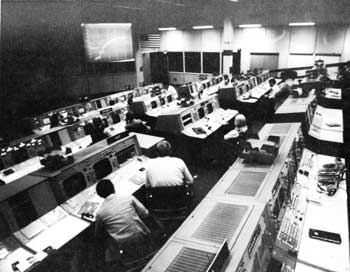.gif)
|
Man in Space
A National Historic Landmark Theme Study |

|
|
Mission Control Centers |

Interior View of the Mission Operations Control Room.
(Courtesy of NASA, NASA/Houston Public Affairs Office)
Apollo Mission Control Center
| Name: | Apollo Mission Control Center (Mission Control Center) |
| Location: | Lyndon B. Johnson Space Flight Center, Houston, Texas |
| Owner: | National Aeronautics and Space Administration (NASA) |
| Condition: | Excellent, altered, original site |
| Builder/Architect: | NASA |
| Dates: | 1965-Present |
DESCRIPTION
The Apollo Mission Control Center is in Building 30 at the Lyndon B. Johnson Manned Space Flight Center in Houston, Texas. The three-story structure consists of a mission operations wing (MOW), operations support wing (OSW), and an interconnecting lobby wing. The MOW contains systems and equipment required to support the mission control function. The OSW contains offices, laboratory, and technical support areas for the flight operations directorate. The lobby wing provides additional office space and dormitory facilities utilized by flight controllers during space flights of extended duration. The mission control center is supported by an emergency power building that houses standby electrical power and air-conditioning systems in the event that primary sources fail.
Principal systems on the first floor are the real time computer complex and the communications systems. These systems support the dual mission facilities and systems on the second and third floors. The communications system provides the interface between the mission control center in Houston and the manned space flight network and the launch site.
Principal areas on the second floor are the mission operations control room (MOCR), the staff support rooms (SSR), the simulation facilities, and the master digital command system. The MOCR is the principal command and control center, staffed with key mission operations teams responsible for overall management of the flight.
Principal areas on the third floor are the MOCR, the SSR, the recovery control room, the meteorological area, and the display and timing area. The MOCR and SSR are exact duplications of the areas on the second floor.
The recovery control room, the meteorological area, and the display and timing areas support the dual mission facilities and systems on the second and third floors.
The MOCR on the second floor is the principal command and decision area in the MCC. Critical information related to spacecraft, launch vehicle, and ground systems, as well as aeromedical parameters from the worldwide stations, ships, and aircraft, is processed and displayed within the MOCR. Based on an analysis of this continuous flow of information, personnel in this room must assess the spacecraft flight status and progress, and then, in time-critical periods, determine the continuation, alteration, or termination of the space flight.
This is an ongoing NASA facility and is currently being modified to accommodate flights of the shuttle. The third floor of the facility has been turned over to the Air Force and is in the process of being converted into a secure area from which Air Force shuttle flights will be monitored. The second floor of the facility housing the mission control operations room is being divided into two rooms to accommodate increasing numbers of shuttle flights. [1]
STATEMENT OF SIGNIFICANCE
The Apollo Mission Control Center is significant because of its close association with the manned spacecraft program of the United States. This facility was used to monitor nine Gemini and all Apollo flights including the flight of Apollo 11 that first landed men on the moon. After the end of the Apollo Program this facility was used to monitor manned spaceflights for Skylab, Apollo-Soyuz, and all recent Space Shuttle flights.
The support provided by the Apollo Mission Control Center to the first manned landing on the surface of the moon was critical to the success of the mission. It exercised full mission control of the flight of Apollo 11 from the time of liftoff from Launch Complex 39 at the Kennedy Space Center to the time of splashdown in the Pacific. The technical management of all areas of vehicle systems of Apollo 11 including flight dynamics, life systems, flight crew activities, recovery support, and ground operations were handled here.
Through the use of television and the print news media the scene of activity at the Apollo Mission Control during the first manned landing on the moon was made familiar to millions of Americans. When Neil Armstrong reported his "giant leap for mankind" to Mission Control his words went immediately around the world and into history. The Apollo Mission Control Center and Launch Complex 39 at the Kennedy Space Center are the two resources that symbolize for most Americans achievements of the manned space program leading to the successful first moon landing during the flight of Apollo 11 in July 1969.
FOOTNOTES
1. Harry Butowsky, et. al., Man in Space Reconnaissance Survey (Denver, National Park Service, 1981), pp. 57-8.
BIBLIOGRAPHY
Brooks, Courtney G., Grimwood, James M., Swenson, Loyd S. Chariots for Apollo: A History of Manned Lunar Spacecraft. Washington, D.C.: National Aeronautics and Space Administration, 1979.
Butowsky, Harry, et. al. Man in Reconnaissance Survey. Denver: National Park Service, 1981.
Mission Control Center. Washington, D.C.: National Aeronautics and Space Administration, No Date.
PHOTOGRAPHS
(click on the above photographs for a more detailed view)
Last Modified: Mon, Jan 8 2001 10:00:00 am PDT
man-in-space/space23.htm



 Top
Top